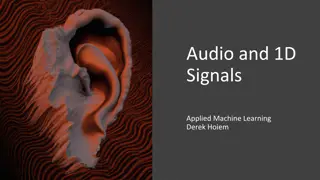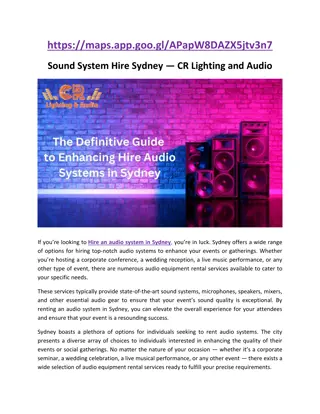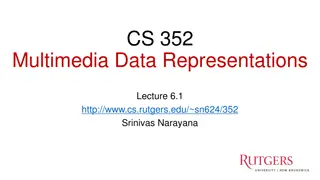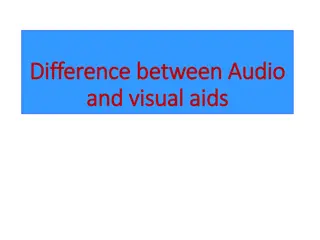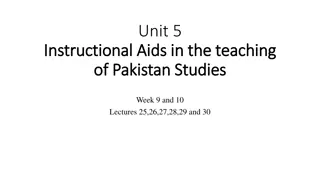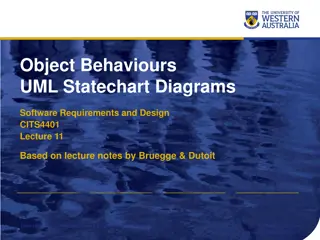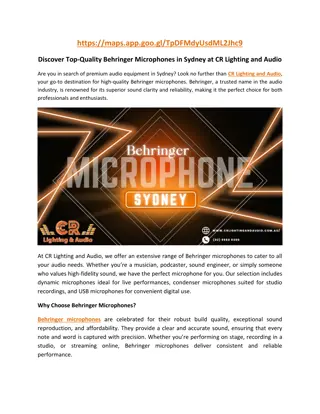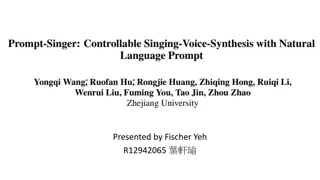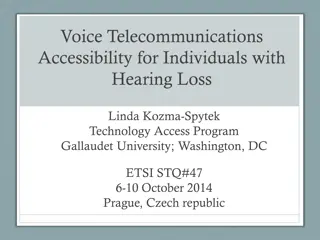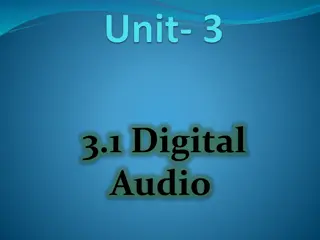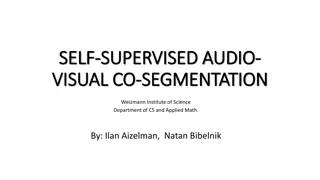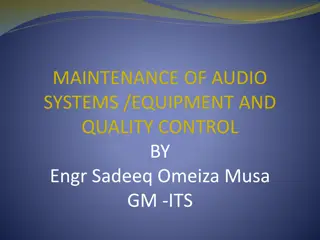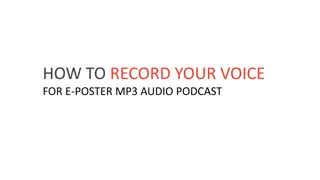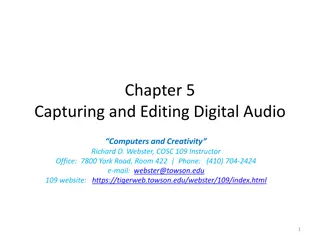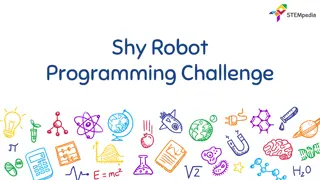Understanding Object-Based Audio Processing
Explore the evolution and key concepts of object-based audio processing, including signal processing on headphones and immersive speaker layouts. Dive into the history of digital audio, audio signal parameters, and the progression of audio technologies from PCM to immersive multi-channel formats for home and cinema. Discover the impact of audio on gaming devices and internet streaming platforms, highlighting key trends in audio technology over the years.
Download Presentation

Please find below an Image/Link to download the presentation.
The content on the website is provided AS IS for your information and personal use only. It may not be sold, licensed, or shared on other websites without obtaining consent from the author. Download presentation by click this link. If you encounter any issues during the download, it is possible that the publisher has removed the file from their server.
E N D
Presentation Transcript
Object-Based Audio: A Signal Processing Overview Sachin Ghanekar
Agenda A brief Overview & History of Digital Audio Basic Concepts of Object Audio & How it works Signal Processing in Object Based Audio on Headphones. Signal Processing in Object Based Audio on Immersive Speaker Layouts Trends and Summary
Audio Signals A snapshot view Parameter Values & Ranges Comment Bandwidth Sound Pressure Level (Signal Energy) 20 Hz to 20 kHz 0 to 120 dB SPL Audible for Human Ear Range of sounds acceptable to Human ear. Note: 1 Pa = 1e-5 bar. Humans can hear sounds wave creating pressure changes less than a billionth of atmospheric pressure. Smallest volume Level change that is perceived by human ear. (1e-12 to 1 W/m2 ) (2e-5 to 20 Pa) OR Loudness Resolution 0.5 dB Digital Audio Sampling Rates 32, 44.1, 48 kHz Oversampled Signals up to 192kHz Recording Levels. 120 dB SPL Audio Input to ADC => 0 dB Full Scale digital output. 16 to 24 bits per sample 120 dB SPL for Full-Range Audio 94 dB SPL for Normal-Range Audio 16 (Lo-Resolution internet audio) & 24 bits (Full-Resolution Audio) Sample Resolution
A Brief History of Audio [1979 1993] : Digital PCM Audio Sampled PCM audio signals LD (1979), CD (1982) , DAT (1987), Sony-MD (1992) MIDI Audio (1983) [1991 2003] : MPEG Stereo Audio Digital Stereo Audio Compression Standards ISO mpeg1,2 and mp3, (1991 to 1998). mp4-aac (2003) [1996 2007] : Digital Radio/TV Broad-Cast Audio Digital Video & Stereo Audio Compression Standards DTV/ATSC standards for TV broadcast Video: 1998 (mp1), 2009 (H264/AVC) Audio: mp2 and Dolby-AC3-multi channel Digital Radio Broadcast DAB stereo (1995 (mp2), 2006 (aac) till now) [1997 onwards] : Immersive Multi-Channel Audio (Cinema/Home) Dolby/DTS Multi-Channel Immersive Audio for Home, Theater VCD (1994 mp2 audio), DVD (1997 ac3/dts5.1 audio), BlueRay (2006 dd+/dts-hdaudio) Dolby/DTS encoded sound tracks for Movies, Songs & Concerts.
A Brief History of Audio [1987 onwards] : Audio for Gaming Devices MIDI and FM synthesis. (Synthetic Audio Sounds) ATARI Gaming Consoles 1987+, Game Boy, Nintendo Gaming Gadgets 1989-1996 CD-Audio Tracks (Natural + Synthetic Audio) [1994 onwards] SEGA Saturn, Sony PS 1994 onwards PCM stereo Audio Microsoft XBOX, Sony PS2 Immersive Audio Dolby/DTS 8 channels compressed audio. Next: XBOX, PS2+ - 3D Audio experience. Immersive, 3D-Audio Tracks (Immersive Audio & Sounds) [2014 onwards] XBOX One Sony PS3 / [2005 onwards] : Audio for Internet Streaming & Mobile Devices Most popular stereo standards (mp3, aac, wma, real) Low Power DSPs, Low bit-rate stereo audio standards Bitrates requirements are 40 to 256 kbps high-resolution upto 640 kbps.
A Brief History of Audio DTV & DAB Digital PCM Audio Broadcast 1979 1995 MPEG Stereo Audio Object Based Audio Theater, Cinema Multi-channel Audio 1991 2013 1997 PC & Gaming Audio Internet Streaming & Mobile Audio 1987 2005
Basics of Object Based Audio What is an Object Based Audio? Audio which is generated by OR a Stationary or moving object a class of objects that are clubbed together as a collective source of sound Some Examples of Audio Objects are: A Stage artiste Ocean waves, wind blowing A moving Train Chorus A bullet fired Birds chirping Cheering Crowd at Cricket ground A monologue or a dialogue An Airplane or A Helicopter
Examples of Object-Based Audio Audio Scene or Sound Field generated by mixing (not just adding) audio signals from multiple Objects. Following are a few examples. Watching a football match in a stadium with home crowd. (Sports TV Channel) 3 objects : Home Crowd as a ring object, Commentator as a point object, Players-Umpire conversations as another object. Participating as a player in a field game. (Computer Games) 4+ objects : Home Crowd as a ring object around you, Commentator as a point object, Player s own voice responses as a point object, Other Players-Umpire as multiple moving objects. Being a part of Scuba-diver team searching an underwater treasure. (VR) Listening to a conversation between different actors & backgrounds in a movie scene. (cinema) Attending a music concert or a simple Hindustani classical music mehafil (concert)
Basics of Object-Based Audio A YouTube examples of Audio Scene with different Objects: http://youtube search "UDK + SuperCollider for real-time sound effect synthesis - demo 6 Observe the Video carefully & Identify -- Number of Audio Objects present in the scene. Shape of the objects Movement of those objects. Appearance / Disappearance of objects Properties of the audio signals generated by these objects.
Channel Based Audio vs Object Based Audio Channel Based Immersive Audio Object Based Audio Content Creation Each signal track is associated with a specific speaker feed & setup at listener end. Content is created for a specific Listener Environment or setup. (mobile, home, or theater) Audio Object based signal tracks are independent of speaker-setup. => Content created is independent Listener Environment or setup. (mobile, home, or theater) Playback at Listener End At Listener end, the contents (channels) are mapped onto user speaker setup Need to use Predefined channel-mapping to headphones, stereo speaker, 2.1, 5.1, 11.1 etc. At Listener end, the objects are mapped onto user speaker setup Objects based on positions and movements are mapped on the fly to the speaker-setup.
Channel Based Audio vs Object Based Audio Channel Based Immersive Audio Object Based Audio Content Creation Audio Objects can be simply identified encoded as separate tracks. With inputs as the recorded contents or tracks, each Channel track is carefully designed and created at the recording studios. OR at the gaming developer studios for creating good immersive effects. Associated meta-data should be carefully designed to capture shape, movement, appearance/disappearance of the objects assuming the listener at the center. Playback at Listener End If the content-target speaker == user speaker setup, then simple-mapping and playback. Else use some good pre-defined maps and delays for rear speakers to create the content. Objects are decoded to create audio signals. Frame-by-Frame, positions of active objects are mapped on to user speakers in form of gains and delays for these objects. Mix and playback.
Channel Based Audio vs Object Based Audio Channel Based Immersive Audio Object Based Audio Content Creation Creation and encoding object-audio is a relatively simpler process and can be done without much pre-thinking of user-setups & environment. Audio object meta-data needs to be carefully associated with it. Creation is a complex careful process. Encoding steps and procedure is complex and hence is done by skilled well trained sound designers. Playback at Listener End Decoders are simple (as simple as channel based Audio). However the Renderers are much more complex. Renderers need to map these objects with its positions to speakers on a frame-by-frame basis. Decoders are Renderers are fairly simple.
Pros & Cons of Object Based-Audio PROS CONS Richer Immersive experience Better user control & available choices for different audio-settings & preferences Decoder+Renderer complexity is about 2x to 3x times higher. Hence the power consumption during playback of such stream is higher. Same content can supports a much larger variety of playback speaker setups from simple Headphones to 22.2 setup. Readily maps to Gaming & VR requirements where user context is NOT defined and varies based on user s navigation.
A summary basic of Object-Based Audio Typical Object-Audio Encoded Stream contains 8 to 16 encoded audio object-tracks. And each audio-object track has two parts Object Audio Track Enc-Audio-Obj Frame 1 Enc-Audio-Obj Frame 2 Enc-Audio-Obj Frame N MetaData-Obj Frame 1 MetaData-Obj Frame 2 MetaData-Obj Frame N Meta-Data: Compressed PCM Audio-Data: Stream-level: Max Number of Audio Objects present in the scene. Standard DD or AAC encoded audio signals associated with a specific object. Frame-level: Shape of the object, Data related to position, speed of the object, Appearance / Disappearance of object
Revisit basic of Object-Based Audio A YouTube examples of Audio Scene with different Objects: http://youtube search "UDK + SuperCollider for real-time sound effect synthesis - demo 6 Observe the Video carefully & Identify -- 4-5 object of different shapes appear, move and disappear w.r.t. to the listener. Footsteps, lava-pond, whirling wind, flowing stream, dripping water
Object-Based Audio Stream Decoding & Rendering Decoding: The basic audio from object is encoded using standard legacy encoders. Therefore, decoding uses standard mp3, aac, dolby-digital decoding to provide basic audio PCM for the object. Renderers: Challenges are in Rendering the decoded object-based audio PCM contents & use object s shape/motion meta-data to create An immersive audio experience on headphones. (VR, Gaming, smartphones, and tablets) An immersive audio experience on our multi-speaker layouts at homes or theaters
Object-Based Audio Renderer on Headphones HRTF Model (Head Related Transfer Function) Ear impulse & frequency response for orientation shown in picture on left (90 azimuth, 0 - elevation) from WK SDO set. [2,3] Diagram of spherical coordinate system (Wightman and Kistler, Univ Winsconsin) 1989 [1] (Note: 5 to 9 msec duration impulse response width @ 16kHz sample rate)
Object-Based Audio Rendering on Headphones FIR Filter Pair Gain / delay Module HRTF_Left MIXER HRTF_Right Decoded audio object PCM data Interpolate & Compute HRTF_Left & HRTF_Right from filter- pool Distance -> Gain delay mapping Decoded audio object Meta data (dist, azi, ele) R & HRTF_L/R Filter pool for diff values of i & i
Object-Based Audio Rendering on Headphones Gain delay Module FIR Filter Pair HRTF_Left MIXER HRTF_Right Decoded audio object PCM data Compute HRTF_Left & HRTF_Right Distance -> Gain, delay mapping Decoded audio object Meta data (dist, azi, ele) R Preset FIR Filter pool & The parameters R, & change every frame (20-30 msec) filter coeffs, gain change every frame This may cause glitches, distortions in the outputs. Need for techniques to adaptively & smoothly change those coefficients Need for fade-in / fade-out / mute of output PCM samples Need for a well-designed multi-port PCM mixing module gain application Module. Oversampling & Interpolation would be required. object position parameters from the above 2 sets R, & There are multiple objects & some appear and disappear after a few frames. Need for on the fly object pcm + associated meta-data memory allocation, update and destruction Doppler effect on audio signal (e.g. a fast-train passing by) Need for pitch shifting (variable-delay) module to be introduced on top of Additional module to Perform 3-D geometry computations to derive final Processing Challenges Some Objects move very rapidly R changes w.r.t. time => the speed of the object is substantial causing An additional Head-Tracking or Joystick movements module which feeds user orientation parameters Ru, u& u VR / Computer Games related: Head / Joystick movements changes R, & Signal
Object-Based Audio Rendering on Headphones FIR Filter Pair Gain / delay Module HRTF_Left MIXER HRTF_Right Decoded audio object PCM data Compute HRTF_Left & HRTF_Right Distance -> Gain & delay mapping Decoded audio object Meta data (dist, azi, ele) R Preset FIR Filter pool & Youtube: Example on You-Tube A Quick RealSpace 3D v0.9.9 Audio Demo - YouTube (courtesy: http://realspace3daudio.com/demos/)
Object-Based Audio Rendering on Immersive Speaker-Layouts Examples of Immersive Speaker Layouts Dolby ATMOS 11.1 Speaker Layouts DTS / DD+ 7.1 Speaker Layout
Object-Based Audio Renderer on Immersive Speaker-Layouts Examples of Immersive Speaker Layouts DTS-X 7.2.4 Speaker Layout DTS Neo:X 11.1 Speaker Layout
Object-Based Audio Renderer on Immersive Speaker-Layouts Examples of Immersive Speaker Layouts Auro-3D 11.1 Speaker Layout Auro-3D 13.1 Speaker Layout
Object-Based Audio Renderer on Immersive Speaker-Layouts Observations on most recent Immersive Speaker Layouts 1. The additional speakers and their positions are fixed as recommended by the Home- Theatre AVR vendors & content creators. 2. A couple of front wide speakers are added in front to cover azimuth angle better. 3. About 2 to 3 speakers at higher elevations are also added to cover audio coming from higher elevation angles. 4. In some cases, there are direct overhead speakers which are fitted in the ceiling (or its effects are virtually created by upward-tilted speakers using ceiling reflections)
Object-Based Audio Renderer on Immersive Speaker-Layouts Two Main Techniques. VBAP Vector based amplitude Panning: Mapping object audio to Virtual Speaker Array HOA Higher Order Ambisonics : Creating desired Sound-Field at listeners sitting position VBAP (Vector Based Amplitude Panning): A large array of Virtual Speaker Positions are assumed to surround the listener. Audio- Objects and their motions / positions w.r.t. the listener are mapped on a larger set of Virtual Speaker Positions. Audio signals for each object is mapped on this virtual speaker positions using VBAP method The audio associated with virtual speakers is then mapped to standard user speaker layouts using pre-defined down-mixing matrices & set of delays.
VBAP based object rendering on Immersive Speaker-Layouts Vector Base Amplitude Panning 3D-VBAP describes/derives sound-field of an object kept on unit sphere by means of 3 relevant channel unit vectors. These channel position vectors need not be orthogonal to each other correspond to nearest speaker positions. (real or virtual) When the 3 channel position vectors are orthonormal (e.g. on x, y, z axis), 3D-VBAP mapping gets simplified to 1st order mapping. [Pulkki 1997]
VBAP based object rendering on Immersive Speaker-Layouts Vector Base Amplitude Panning [Pulkki 1997] P = [g1 g2, g3] x [L1, L2, L3] = object Position & loudness vector. where [g] is gain 3x1 vector, L = [L1, L2, L3] is 3x3 matrix formed by of x,y,z co-ordinates of Virtual Speaker positions L1, L2, L3. P is Audio Object representation vector with direction & amplitude [g1, g2, g3] = P * L-1 Typically, the space around the listener is divided into 80 to 100 valid triangular meshes or region. The object is mapped in one of the regions The object-audio stream is created by encoding P values and sent as meta-data for the object. At the renderer, the matrices L-1 are pre-computed and stored for the triangular meshes. The gains g1, g2, g3 are calculated as (P * L-1) for the object. The gains are applied to the audio object PCM data to create the audio-signals to be played at the virtual speaker positions
HOA based object rendering on Immersive Speaker-Layouts Higher Order Ambisonics [Gerzon 1970] Creates a sound field generated by audio-object(s) when it gets captured by directional microphones located at the listener s position First Order Ambisonics fields Second Order Ambisonics fields An Ambisonic Microphone HOA channels are encoded and these channels are decoded and then mapped onto any standard user speaker layouts from 5.1, or 7.2.4 or 13.1 . These mappings are easy and less complex. HOA technique makes it easy to modify the sound-field for different user (listener) orientations (required mainly in VR & Computer Gaming)
Rendering on Headphones using intermediate audio of Immersive Speaker-Layouts In industry, typically the following technique is used (in non-gaming) application to render the object-based content on headphones. Decode and render the object based content for an Immersive Speaker layout. Map the immersive speaker layout audio signals to headphones using BinAural Rendering Advantages are: The same content can be decoded for immersive speaker layout, theater, or headphones. Reduced Complexity if the stream carries standard immersive channel configurations as sub- stream then this can be done as multi-channel decoding followed by Bin-Aural Rendering.
BinAural Rendering : Immersive Speakers -> Headphones. Left Rear Speaker Signal Lsr Depending upon the fixed & angles of Front, Rear & Overhead Speakers w.r.t. Left and Right ear of the listener HRTF_LeftEar_Lsr HRTF_RightEar_Lsr Right Rear Speaker Signal Rsr HRTF_Left and HRTF_right are applied & mixed as below. HRTF_LeftEar_Rsr HRTF_RightEar_Rsr Left Front Speaker Signal Lf HRTF_LeftEar_Lf + HRTF_RightEar_Lf Right Front Speaker Signal Rf HRTF_LeftEar_Rf + HRTF_RightEar_Rf Let s Listen to YouTube: Hear New York City in 3D Audio (BinAural Audio) Duration of Interest: 1.30-6.00 min Overhead Speaker Signal Oh HRTF_LeftEar_Oh HRTF_RightEar_Oh
Industry Trends for Object-Based Audio Reference Material based on Object-Audio: Dolby, DTS and Fraunhofer are introducing their freshly designed audio standard reference IPs which support Object-based audio contents for Cinema, Home theater and Digital broadcasts. Gaming industry and VR gadgets manufacturers are welcoming this trend in their domains. For listeners, this trend will provide Better immersive experience for the latest movie releases and audio contents on their existing home theater setup. Streaming contents & games on mobile phones / tablets would sound much richer. The Sports channels & movies will carry more options for user controls to select audio environments for watching their favorite match. Upgrading to the latest AVRs and SoundBars with wide front and ceiling with overhead speakers (actual or virtual) will provide the best effects. For DSP solution providers: Higher computational burden on Audio DSPs to decode and especially rich post processing to render the content. Audio DSP gets burdened with 3-D geometry computations, computes related to square-root, sine, cos, matrix operations are required. Compute Power required to decode this content is going to be 2 to 3x higher, thus battery drain may be higher.
Summary of Object-Based Audio Each sound source is captured as an object which is associated with compressed audio as payload and motion/shape information as meta-data. For listener using Headphones, objects along with its motions are mapped to left and right ear from a pool of pre-generated HRTF (Head related transfer functions) functions. For listener sitting in living room or cinema theaters, objects along with its motions are mapped onto an array of immersive speaker layouts, using VBAP, HOA methods. The content creators also use combination of the above two methods called Bin-aural rendering to render the contents for creating immersive audio perception on the Headphones.
Thank you Q & A Session?
References [1] http://youtube search "UDK + SuperCollider for real-time sound effect synthesis - demo 6 [2] http://alumnus.caltech.edu/~franko/thesis/Chapter4.html (HRTF related discussions & details) [3] Headphone simulation of free-field listening. I- Stimulus synthesis - J Acoust Soc Am 1989 - Wightman.pdf ("SDO" HRTF by Wightman and Kistler from Department of Psychology and Waisman Center, University of Wisconsin--Madison, Madison, provided a basis for HRTF research) [4] http://youtube search " RealSpace 3D v0.9.9 Audio Demo YouTube Ref: http://realspace3daudio.com/demos/ [5] http://slab3d.sourceforge.net/ - Simple HRTF code to try out simulations of moving audio-objects. [6] Virtual Sound Source Positioning Using VBAP, Ville Pulkki, Journal of Audio Engg. Society, Vol 45, No 6, June 1997 [7] Spatial Sound Technologies and Psychoacoustics, presentation by V. Pulkki in IEEE Winter School in 2012 at Crete, Greece. [8] An Introduction to Higher Order Ambisonic, Florian Hollerweger, Oct 2008 [9] http://youtube search Hear New York City in 3D Audio (1st short clip)


